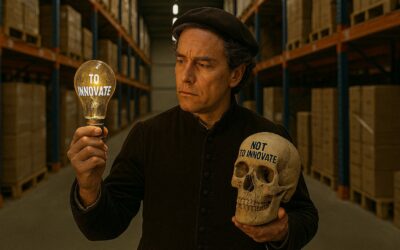Many organisations are battling on all fronts in today’s complex business environment. Service-level issues are dragging down sales. COOs are working overtime to strengthen brittle supply chains. CIOs are grappling with mandatory SAP upgrades from R/3 to S/4 HANA. And amidst it all, AI and digitisation are hailed as silver bullets—but often feel like distant promises in the face of real, immediate challenges.
If this sounds familiar, you’re not alone. We’ve been here before. And there are pragmatic answers—if you know where to look.
A Familiar, Frustrating Scenario
Picture this: a salesperson lands a €70k order. However, the deal falls apart because logistics can’t authorise an extra €300 for a non-standard shipment. Procurement won’t deviate from the lowest-cost supplier policy, and the CFO frowns on unapproved spending. Result? No delivery. No sale. Everyone, from Sales to the CEO, ends up unhappy.
Meanwhile, the same company ships €20 of product on a full Europallet because the end-to-end cost isn’t visible in the ERP. These are not isolated issues—they’re symptoms of something more profound.
How Did We Get Here?
To understand the current storm, we need to look back:
- 1960s–70s: The Toyota Production System was born—lean thinking focused on eliminating waste.
- 1990s–2000s: Lean went mainstream. SAP R/3 took hold, often implemented in haste to meet Y2K deadlines. The goal? One global standard. The reality? A rigid, one-size-fits-all model.
- Post-2000: Standardisation overreached, causing the loss of unique, competitive practices. Workarounds proliferated, and “Z-tables” and custom fixes became the norm.
- 2008–09: The financial crisis killed off operational buffers. Businesses cut costs—at the expense of resilience.
- Today: The fallout from COVID-19, geopolitical conflict, and volatile markets has exposed how fragile our global value chains have become.
Despite best-in-class systems, many organisations are paralysed—stuck between old models that no longer serve and new technologies that seem out of reach.
A Tipping Point
Now, companies are facing a non-negotiable S/4 HANA upgrade while trying to address years of exceptions and legacy workarounds. The temptation? Treat it as a technical lift-and-shift. The danger? Rebuilding yesterday’s broken system in today’s architecture—at significant cost.
Too often, traditional consulting models offer functional optimisation within silos—without tackling cross-functional misalignment. The result? Expensive transformations that fail to deliver.
Why Radical Change Feels So Hard
Every executive knows we need a step change. But with budgets tight and stakes high, the path forward is unclear.
- Should we bet on AI and unproven digitisation strategies?
- Can we trust traditional consultancies that offer more of the same?
- Are there still classic improvement levers we haven’t yet pulled?
At AB Advisors, we believe the answer lies in coordinated, function-crossing action—not more silos or complexity. That starts by realigning functional strategies and accepting that sub-optimisation in one area may be the price of improving performance across the board.
What We Recommend
Rather than wait for a perfect solution, start by acting. Here’s how we help clients weather the storm:
- Reconnect your operations to strategy: Even modest functional improvements can have an exponential impact when adequately aligned.
- Simplify: Elegant, basic changes—when implemented with the right timing and cross-functional support—often outperform expensive, overengineered ones.
- Don’t wait for the AI revolution: Focus on fixing what you can now. AI works best in clean, well-aligned systems.
As one of our clients said, “You can’t make an omelette without breaking eggs.” The courage to make pragmatic, informed decisions is what separates those who navigate the storm from those who drift.
Let’s Talk
This storm is real. But so is the opportunity to emerge stronger.
At AB Advisors, we combine deep operational insight with a passion for simplification. We work hands-on with your teams to restore clarity, reduce cost, and rebuild resilience. Let’s have a conversation about what’s keeping you stuck—and what’s next.
Please share your thoughts in the comments below or contact us to discuss your plans in more detail.










0 Comments